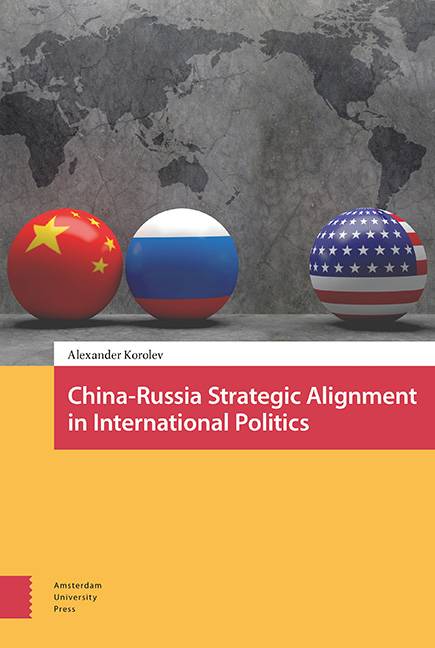Book contents
- Frontmatter
- Dedication
- Table of Contents
- List of Figures and Tables
- Acknowledgments
- 1 Introduction: The Elusive Nature of China–Russia Relations and the Need for Theory
- 2 The Ordinal Model of Strategic Alignment
- 3 Military Cooperation: Approaching Alliance
- 4 Alignment Incentives: The Three Balances
- 5 Robustness Check: Economy and Diplomacy
- 6 Comparative Mapping: US–India and China–Russia Alignments
- 7 Conclusion: Empirical Findings and Theoretical Implications
- Index
2 - The Ordinal Model of Strategic Alignment
Published online by Cambridge University Press: 07 October 2022
- Frontmatter
- Dedication
- Table of Contents
- List of Figures and Tables
- Acknowledgments
- 1 Introduction: The Elusive Nature of China–Russia Relations and the Need for Theory
- 2 The Ordinal Model of Strategic Alignment
- 3 Military Cooperation: Approaching Alliance
- 4 Alignment Incentives: The Three Balances
- 5 Robustness Check: Economy and Diplomacy
- 6 Comparative Mapping: US–India and China–Russia Alignments
- 7 Conclusion: Empirical Findings and Theoretical Implications
- Index
Summary
Abstract
This chapter synthesizes the literature on alliances, alignments, and strategic partnerships to develop an ordinal framework that offers a way to systematically assess the degree and the causes of strategic alignment. The framework's first cluster covers the degree of institutionalization of intermilitary relations by identifying seven indicators of military cooperation grouped into three stages of early, moderate, and advanced cooperation. The second cluster covers alignment incentives that are gauged by the three balances and the related theories of alignment formation – the balance of power, the balance of threat, and the balance of interests. While the primary emphasis is on military cooperation as the backbone of alignment, the chapter also suggests assessments of economic and diplomatic cooperation as a “robustness check” to explore whether the relationship goes beyond military realm.
Keywords: alignments, military cooperation, economic cooperation, balance of power
As mentioned in Chapter , the lack of a universal alignment framework seriously complicates the empirical assessment of interstate strategic cooperation. Even the definitions of a more conventional term – “alliance” – vary in terms of comprehensiveness and precision. According to Walt (1987, p. 1), both “formal” and “informal” relationships of security cooperation between sovereign states qualify as an alliance. Weitsman (2003, p. 7) provides an even broader definition according to which alliances are agreements that simply provide “some element of security” to the participants. Snyder (1997, p. 4) defines alliances as “formal associations of states for the use (or non-use) of military force, in specified circumstances, against states outside their own membership.” The emphasis on formality (formal treaties) as an attribute of alliances helps to narrow down the definition significantly, but it excludes a range of important and strategically consequential informal alignments.
The alignment framework offered in this book begins with the assumption that alignment formation is a stadial process in the sense that the development of a functioning alignment takes time, and interstate strategic cooperation must pass an early and a moderate stage before it moves into an advanced stage and, hence, a tighter alignment. States are not likely to become closely aligned overnight. While they may rush into a bonding alliance treaty in response to an external threat or shock, the actual functionality of such an alliance, as well as the compatibility and interoperability of the allies’ military forces, is likely to be questionable, unless the actors involved have already had a history of comprehensive strategic cooperation.
- Type
- Chapter
- Information
- Publisher: Amsterdam University PressPrint publication year: 2022

